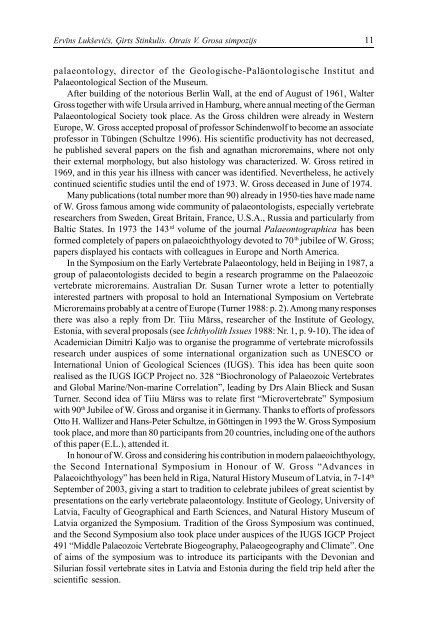Zemes un vides zinātnes Earth and Environment Sciences - Latvijas ...
Zemes un vides zinātnes Earth and Environment Sciences - Latvijas ...
Zemes un vides zinātnes Earth and Environment Sciences - Latvijas ...
You also want an ePaper? Increase the reach of your titles
YUMPU automatically turns print PDFs into web optimized ePapers that Google loves.
Ervīns Lukševičs, Ģirts Stinkulis. Otrais V. Grosa simpozijs<br />
11<br />
palaeontology, director of the Geologische-Paläontologische Institut <strong>and</strong><br />
Palaeontological Section of the Museum.<br />
After building of the notorious Berlin Wall, at the end of August of 1961, Walter<br />
Gross together with wife Ursula arrived in Hamburg, where annual meeting of the German<br />
Palaeontological Society took place. As the Gross children were already in Western<br />
Europe, W. Gross accepted proposal of professor Schindenwolf to become an associate<br />
professor in Tübingen (Schultze 1996). His scientific productivity has not decreased,<br />
he published several papers on the fish <strong>and</strong> agnathan microremains, where not only<br />
their external morphology, but also histology was characterized. W. Gross retired in<br />
1969, <strong>and</strong> in this year his illness with cancer was identified. Nevertheless, he actively<br />
continued scientific studies <strong>un</strong>til the end of 1973. W. Gross deceased in J<strong>un</strong>e of 1974.<br />
Many publications (total number more than 90) already in 1950-ties have made name<br />
of W. Gross famous among wide comm<strong>un</strong>ity of palaeontologists, especially vertebrate<br />
researchers from Sweden, Great Britain, France, U.S.A., Russia <strong>and</strong> particularly from<br />
Baltic States. In 1973 the 143 rd volume of the journal Palaeontographica has been<br />
formed completely of papers on palaeoichthyology devoted to 70 th jubilee of W. Gross;<br />
papers displayed his contacts with colleagues in Europe <strong>and</strong> North America.<br />
In the Symposium on the Early Vertebrate Palaeontology, held in Beijing in 1987, a<br />
group of palaeontologists decided to begin a research programme on the Palaeozoic<br />
vertebrate microremains. Australian Dr. Susan Turner wrote a letter to potentially<br />
interested partners with proposal to hold an International Symposium on Vertebrate<br />
Microremains probably at a centre of Europe (Turner 1988: p. 2). Among many responses<br />
there was also a reply from Dr. Tiiu Märss, researcher of the Institute of Geology,<br />
Estonia, with several proposals (see Ichthyolith Issues 1988: Nr. 1, p. 9-10). The idea of<br />
Academician Dimitri Kaljo was to organise the programme of vertebrate microfossils<br />
research <strong>un</strong>der auspices of some international organization such as UNESCO or<br />
International Union of Geological <strong>Sciences</strong> (IUGS). This idea has been quite soon<br />
realised as the IUGS IGCP Project no. 328 “Biochronology of Palaeozoic Vertebrates<br />
<strong>and</strong> Global Marine/Non-marine Correlation”, leading by Drs Alain Blieck <strong>and</strong> Susan<br />
Turner. Second idea of Tiiu Märss was to relate first “Microvertebrate” Symposium<br />
with 90 th Jubilee of W. Gross <strong>and</strong> organise it in Germany. Thanks to efforts of professors<br />
Otto H. Wallizer <strong>and</strong> Hans-Peter Schultze, in Göttingen in 1993 the W. Gross Symposium<br />
took place, <strong>and</strong> more than 80 participants from 20 co<strong>un</strong>tries, including one of the authors<br />
of this paper (E.L.), attended it.<br />
In honour of W. Gross <strong>and</strong> considering his contribution in modern palaeoichthyology,<br />
the Second International Symposium in Honour of W. Gross “Advances in<br />
Palaeoichthyology” has been held in Riga, Natural History Museum of Latvia, in 7-14 th<br />
September of 2003, giving a start to tradition to celebrate jubilees of great scientist by<br />
presentations on the early vertebrate palaeontology. Institute of Geology, University of<br />
Latvia, Faculty of Geographical <strong>and</strong> <strong>Earth</strong> <strong>Sciences</strong>, <strong>and</strong> Natural History Museum of<br />
Latvia organized the Symposium. Tradition of the Gross Symposium was continued,<br />
<strong>and</strong> the Second Symposium also took place <strong>un</strong>der auspices of the IUGS IGCP Project<br />
491 “Middle Palaeozoic Vertebrate Biogeography, Palaeogeography <strong>and</strong> Climate”. One<br />
of aims of the symposium was to introduce its participants with the Devonian <strong>and</strong><br />
Silurian fossil vertebrate sites in Latvia <strong>and</strong> Estonia during the field trip held after the<br />
scientific session.
















